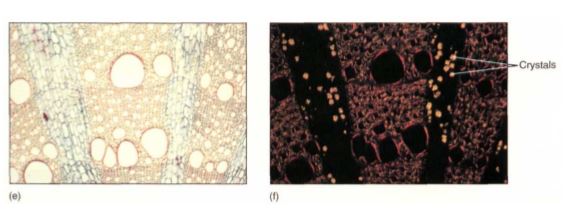

النبات

مواضيع عامة في علم النبات

الجذور - السيقان - الأوراق

النباتات الوعائية واللاوعائية

البذور (مغطاة البذور - عاريات البذور)

الطحالب

النباتات الطبية


الحيوان

مواضيع عامة في علم الحيوان

علم التشريح

التنوع الإحيائي

البايلوجيا الخلوية


الأحياء المجهرية

البكتيريا

الفطريات

الطفيليات

الفايروسات


علم الأمراض

الاورام

الامراض الوراثية

الامراض المناعية

الامراض المدارية

اضطرابات الدورة الدموية

مواضيع عامة في علم الامراض

الحشرات


التقانة الإحيائية

مواضيع عامة في التقانة الإحيائية


التقنية الحيوية المكروبية

التقنية الحيوية والميكروبات

الفعاليات الحيوية

وراثة الاحياء المجهرية

تصنيف الاحياء المجهرية

الاحياء المجهرية في الطبيعة

أيض الاجهاد

التقنية الحيوية والبيئة

التقنية الحيوية والطب

التقنية الحيوية والزراعة

التقنية الحيوية والصناعة

التقنية الحيوية والطاقة

البحار والطحالب الصغيرة

عزل البروتين

هندسة الجينات


التقنية الحياتية النانوية

مفاهيم التقنية الحيوية النانوية

التراكيب النانوية والمجاهر المستخدمة في رؤيتها

تصنيع وتخليق المواد النانوية

تطبيقات التقنية النانوية والحيوية النانوية

الرقائق والمتحسسات الحيوية

المصفوفات المجهرية وحاسوب الدنا

اللقاحات

البيئة والتلوث


علم الأجنة

اعضاء التكاثر وتشكل الاعراس

الاخصاب

التشطر

العصيبة وتشكل الجسيدات

تشكل اللواحق الجنينية

تكون المعيدة وظهور الطبقات الجنينية

مقدمة لعلم الاجنة


الأحياء الجزيئي

مواضيع عامة في الاحياء الجزيئي


علم وظائف الأعضاء


الغدد

مواضيع عامة في الغدد

الغدد الصم و هرموناتها

الجسم تحت السريري

الغدة النخامية

الغدة الكظرية

الغدة التناسلية

الغدة الدرقية والجار الدرقية

الغدة البنكرياسية

الغدة الصنوبرية

مواضيع عامة في علم وظائف الاعضاء

الخلية الحيوانية

الجهاز العصبي

أعضاء الحس

الجهاز العضلي

السوائل الجسمية

الجهاز الدوري والليمف

الجهاز التنفسي

الجهاز الهضمي

الجهاز البولي


المضادات الميكروبية

مواضيع عامة في المضادات الميكروبية

مضادات البكتيريا

مضادات الفطريات

مضادات الطفيليات

مضادات الفايروسات

علم الخلية

الوراثة

الأحياء العامة

المناعة

التحليلات المرضية

الكيمياء الحيوية

مواضيع متنوعة أخرى

الانزيمات
Cell Storage Products-Crystals
المؤلف:
AN INTRODUCTION TO PLANT BIOLOGY-1998
المصدر:
JAMES D. MAUSETH
الجزء والصفحة:
23-10-2016
2719
Cell Storage Products—Crystals
Many plants contain numerous crystals; the most common crystalline compound is calcium oxalate, which often forms round masses of angular crystals. We are not certain what role calcium oxalate crystals play in the biology of plants, but two hypotheses have been suggested which could both be correct. One hypothesis postulates that the crystals are a means of reducing the amount of calcium ion (Ca2+) in the cytoplasm. Calcium regulates the activity of many enzymes, activating some as its concentration increases and inactivating others. Consequently, it is important for the amount of free calcium to be controlled carefully. By combining calcium with oxalic acid and forming a crystal, an atom of calcium is inactivated as far as any enzyme is concerned. The second hypothesis postulates that the presence of crystals makes plant tissues unpalatable for animals to eat. Consequently, tissues that have crystals are protected from feeding animals. If this hypothesis is a good model of reality, we would expect to find crystals particularly abundant in important tissues. The accompanying illustrations are micrographs of some tissues that are consistent with the second hypothesis. In each, crystals occur predominantly near tissues that might be the target of insect feeding. The micrographs on the left of each pair were made with ordinary light; those on the right used polarized light to reveal crystals more clearly.

(a) A leaf clearing of maidenhair tree (Ginkgo), showing several red-stained leaf veins that conduct sugars out of the leaf. Such veins are the targets of aphids and other sucking insects (X 15). (b) The same tissue, in polarized light (X 15).

(c) A midrib, the large vein that runs down the center of a leaf. No crystals are visible with ordinary light (X 50).
(d) Polarized light shows crystals to be abundant in the sugar-conducting tissue. The reddish cells above conduct water; they are free of crystals, but insects do not often attack this type of tissue (X 150).

(e) A cross-section of Aristolochia wood; crystals are present in the two bands of tissue with blue-stained walls (see (f)). This is a soft tissue in wood and is the site where sugars and other nutrients are stored (X 50).
(f) The same tissue as (e), but with polarized light (X 50).
 الاكثر قراءة في مواضيع عامة في علم النبات
الاكثر قراءة في مواضيع عامة في علم النبات
 اخر الاخبار
اخر الاخبار
اخبار العتبة العباسية المقدسة

الآخبار الصحية















 قسم الشؤون الفكرية يصدر كتاباً يوثق تاريخ السدانة في العتبة العباسية المقدسة
قسم الشؤون الفكرية يصدر كتاباً يوثق تاريخ السدانة في العتبة العباسية المقدسة "المهمة".. إصدار قصصي يوثّق القصص الفائزة في مسابقة فتوى الدفاع المقدسة للقصة القصيرة
"المهمة".. إصدار قصصي يوثّق القصص الفائزة في مسابقة فتوى الدفاع المقدسة للقصة القصيرة (نوافذ).. إصدار أدبي يوثق القصص الفائزة في مسابقة الإمام العسكري (عليه السلام)
(نوافذ).. إصدار أدبي يوثق القصص الفائزة في مسابقة الإمام العسكري (عليه السلام)


















